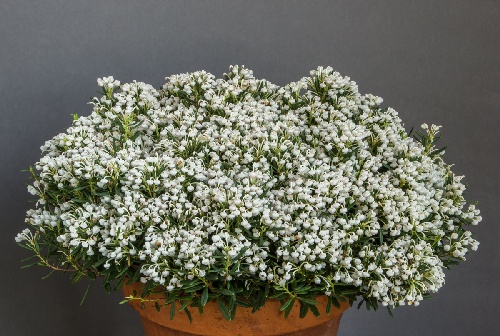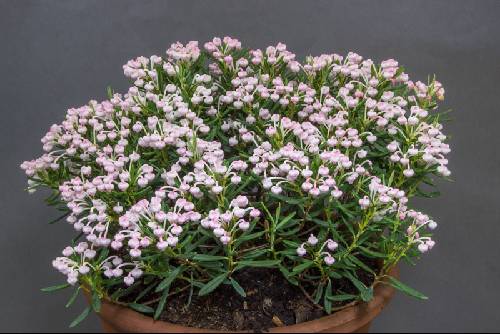Authors: L.
Usually 20-25cm tall with a greater spread. Leaves lanceolate to oval, 2-3cm long and 4-8mm broad. Flowers urceolate, 4-6mm in diameter in clusters of two to five at the branch tips in late spring during the summer. Circumpolar in the northern hemisphere. Tundra and acid boggy ground, mainly in the mountains further south. A.p. 'Alba', syn. A.p. var. compacta alba forms a compact, 15cm tall, free-flowering shrub with attractive green foliage and white flowers. Japan. (Previously a white-flowered form 20-25cm tall bearing the invalid name A.p. var. congesta was widely grown but now seems to have disappeared from gardens. i s16 2 A.p. 'Compacta' applies to a plant of Japanese origin with broad, glaucous leaves 2.5cm long, topped by multi-flowered clusters of pale to mid-pink flowers. As the name suggests, plants are compact, 10-15cm high and slow spreading. A.p. 'Hayachine' named after Mount Hyachine, Honshu is a 20cm high shrublet with dark green, linear leaves 2cm long and masses of freely produced deep rose-pink flowers. A.p. 'Iwasugo' from Hokkaido is a narrow-leaved, vigorous variant up to 25cm in height bearing blush-pink flowers. The needle-like leaves are only 3mm wide by 2cm long. A.p. 'Kirigamine' was introduced from the bog-meadow at Mount Kirigamine west of Tokyo. In cultivation in the western world, its name has frequently been incorrectly spelt 'Kirikaming' or 'Kirikamine'. It has proved to be an excellent garden plant with narrow, green leaves 2cm long and a profusion of mid-pink flowers. It is particularly tolerant of dry conditions. A.p, 'Major' is a robust but sprawling plant with stems up to 60cm long and leaves 3cm by 1cm, considerably larger than the type but sparsely borne, and clusters of small flowers at the tips. Not a very garden-worthy plant. A,p. 'Macrophylla' forms a distinct little scrub, dwarf in habit, but with broad, dark green leaves up to 3cm by 1.5cm, over which fat bunches of pink and white globular flowers are borne in April-May. Very distinct and desirable. A.p. 'Nikko' occurs widely throughout Sejogahara alpine bog in the national park of Nikko, central Honshu. It is robust but compact, 20-25cm in height with 2.3cm long grey-green leaves and light, clear-pink flowers. A.p. 'Shibutsu' is named after the mountain at the Oze alpine bog meadow north of Tokyo. It is a similar plant to A.p. 'Compacta', dwarf, glaucous-leaves and free-flowering. It has proved itself as a garden plant and is one of the most readily available cultivars. The flowers have the iridescent quality of pink and white sugar-icing. A.p. var. minima (syn. A.p. var. acerosa) is an alpine or tundra form of much reduced stature. It makes a low mat, 5-8cm in height with branchlets spreading almost horizontally. The leaves are very narrow, 2cm by 0.3 cm and often purple tinted, especially in winter. Flowers are fewer to the truss, small and varying from pale to deep pink. A fascinating little alpine but never as solidly colourful as the Japanese selections above. The name A.p. var. grandiflora has been applied by the Japanese botanist Nakai to vigorous, broad-leaved forms with big flowers held in large clusters. Most botanists, however, consider that such plants occur so widely spaced and spasmodically throughout the geographical range of the genus and are insufficiently delineated in structure or distribution from the type, that it is unnecessary to retain the distinguishing varietal name. A.p. 'Winter Red' is a recently introduced cultivar with foliage turning to dark reddish-brown during winter. New growth is of a brighter, shining red. This plant does not appear to be very free flowering and tends to become leggy.


Sign up for our newsletter to receive our monthly update direct to your inbox. Featuring our latest articles and news.
Built by Atomic Smash

